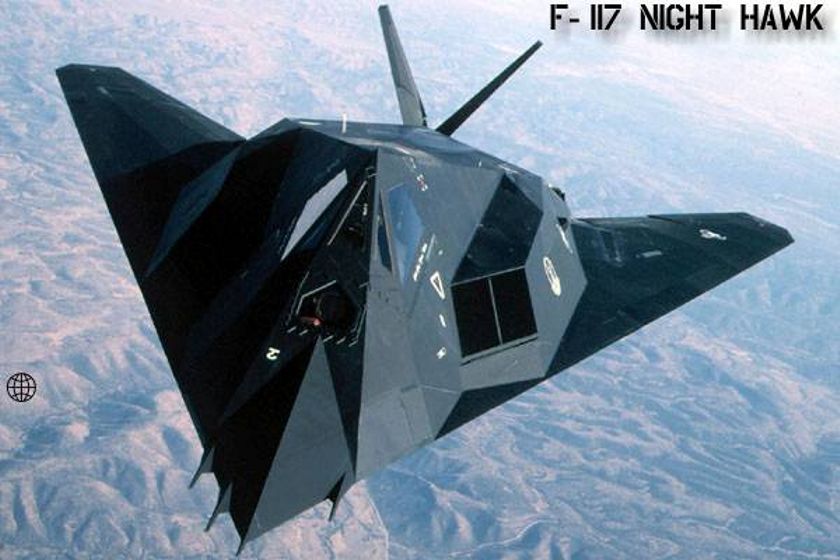F-117 NIGHTHAWK STEALTH FIGHTER, USA

The F-117A Nighthawk Stealth Fighter attack aircraft was developed by Lockheed Martin after work on stealth technology, and the predecessor test demonstrator aircraft, Have Blue, was carried out in secret from 1975. Development of the F-117A began in 1978 and it was first flown in 1981, but it was not until 1988 that its existence was publicly announced. The Nighthawk is the world's first operational stealth aircraft. The first aircraft was delivered in 1982 and the last of the 59 Nighthawks procured by the US Air Force was received in 1990. 55 are still in service.
The F-117A aircraft is also known as the Frisbee and the Wobblin' Goblin. The mission of the aircraft is to penetrate dense threat environments and attack high-value targets with high accuracy. Nighthawk has been in operational service in Panama, during Operation Desert Storm, in Kosovo and during Operation Iraqi Freedom.
The Nighthawk is only used for night-time missions. However, the USAF is evaluating the F-117 for use on daylight operations and one aircraft has been repainted grey for the tests.
In January 2004, an F-117 successfully released a JDAM (JDAM) 2,000lb bomb for the first time. The integration of JDAM and other precision-guided weapons on the F-117 is coupled with the Block II software upgrade and is planned to achieve Initial Operating Capability (IOC) in mid-2006.
DESIGN
The surfaces and edge profiles are optimised to reflect hostile radar into narrow beam signals, directed away from the enemy radar detector. All the doors and opening panels on the aircraft have saw-toothed forward and trailing edges to reflect radar. The aircraft is mainly constructed of aluminum, with titanium for areas of the engine and exhaust systems. The outer surface of the aircraft is coated with a radar-absorbent material (RAM). The radar cross-section of the F-117 has been estimated at between 10-100cm2.
The F-117A has four elevons on the inboard and outboard trailing edge of the wing. The V-shaped tail, which controls the yaw of the aircraft, acts as a flying tail, which means that the whole surface acts as a control surface. The elevons do not act as flaps to reduce the rate of descent for touchdown, so the landing speed of the F-117A is high, at about 180 or 190 miles per hour, and a drag parachute is used.
COCKPIT
The cockpit has a Kaiser Electronics head-up display (HUD) and the flight deck is equipped with a large video monitor, which displays the infrared imagery from the aircraft's onboard sensors. The cockpit has a full-colour moving map developed by the Harris Corporation. The fly-by-wire system is supplied by BAE Systems Aircraft Controls.
WEAPONS
The aircraft can carry a range of tactical fighter ordnance in the weapons bay, including BLU-109B low-level laser-guided bomb, GBU-10 and GBU-27 laser-guided bomb units, Raytheon AGM-65 Maverick and Raytheon AGM-88 HARM air-to-surface missiles.
SENSORS
For stealth, the F-117A does not rely on radar for navigation or targeting. For navigation and weapon aiming, the aircraft is equipped with a forward-looking infrared (FLIR) and a downward-looking infrared (DLIR) with laser designator, supplied by Raytheon. The aircraft uses a Honeywell inertial navigation system.
The aircraft has multi-channel pilot static tubes installed in the nose. Multiple ports along the length of the tubes provide differential pressure readings. The flight control computers compare these in order to provide the aircraft's flight data.
FLIGHT MANAGEMENT
Before flight, mission data is downloaded on to the IBM AP-102 mission control computer, which integrates it with the navigation and flight controls to provide a fully automated flight management system.
After take-off, the pilot can hand over flight control to the mission program until within visual range of the mission's first target. The pilot then resumes control of the aircraft for weapon delivery. The aircraft is equipped with an infrared acquisition and designation system (IRADS), which is integrated with the weapon delivery system. The pilot is presented with a view of the target on the head-up display, first from the FLIR and then from the DLIR. The weapon delivery and impact is recorded on the aircraft's internally mounted video system, which provides real-time damage assessment.
ENGINES
The F-117A is powered by two low-bypass F404-GE-F1D2 turbofan engines from General Electric. The rectangular air intakes on both sides of the fuselage are covered by gratings, which are coated with radar-absorbent material.
The wide and flat structure of the engine exhaust area reduces the infrared and radar detectability of the aft section of the engine. The two large tail fins slant slightly outwards to provide an obstruction to the infrared and radar returns from the engine exhaust area.